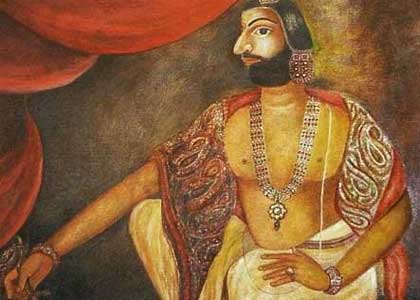History
Kottayam was ruled by the Rajas of the independent little kingdom of Thekkumkoor ruled from Thazhathangady till the mid-18th century. At that time, Marthanda Varma,the king of Travancore annexed Thekkumcore and surrounding areas of Kottayam to the Kingdom of Travancore. During the British rule of India, Kottayam continued to be ruled under the Princely State of Travancore.
The present district of Kottayam was part of erstwhile princely state of Travancore. The Travancore state consisted of two revenue divisions viz., the South and the North, under the administrative control of a Divan Peshkar for each. Later, in 1868, two more divisions, Quilon and Kottayam, were constituted. The fifth division - Devikulam, came next but for a short period, which in course of time was made part of Kottayam.
At the time of integration of the State of Travancore and Cochin in 1984, these revenue divisions were renamed as districts and the Divan Peshkars gave way to District Collectors, giving birth to Kottayam District.
The beginning of of the 9th century A.D. was the reign of Kulashekaras. At that time, Kottayam was a part of the Kulashekara Empire (1090-1102 A.D). The Vembanad Lake itself derives its name from Vempolinad. The Kingdom of Vempolinad, split into kingdoms of Thekkumkur and Vadakkumkur by about 1100 A.D. which later were annexed to Travancore by Marthanda Varma of Travancore (between 1748 and 1754). The Portuguese and the Dutch had their business relations with both Thekkumkur and Vadakkumkur kingdoms, pepper and other spices being the main attractions.

In addition to Thekkumkur and Vadakkumkur, Marthanda Varma brought two more pretty principalities in Kottayam under his control. These were Poonjar and Meenachil.
After Marthanda Varma, Dharma Raja (1758-1798) placed Kottayam in a key position in the new defense strategy against Haider Ali and Tippu Sulthan of Mysore. Apart from this, Kottayam gave asylum to a number of refugee princes who left Malabar in the wake of Mysore invasions.
Kottayam occupied a pre-eminent position in the cultural life of the Travancore princely court, the main reason being the migration of Ramapurathu Warrier, the famous poet of Vadakkumkur, to Triruvananthapuram , following the annexation of Kottayam by Marthanda Varma.
Kottayam has played its role in all the political agitation of modern times. The "Malayali Memorial" agitation may be said to have had its origin in Kottayam. The Malayali Memorial sought to secure better representation for educated Travancoreans in Travancore civil service against persons from outside. The memorial that was presented to Maharaja Sri Mulam Thirunal (1891) was drafted at a public meeting held in Kottayam Public Library. The event marked the beginning of the modern political movement in the state.
It was here that the famous Vaikom Satyagraha, (1924-25) an epic struggle against untouchability took place. Scheduled castes and other backward classes in Travancore were not only denied entry into temples, but also to temple roads. Vaikom, the seat of a celebrated Siva Temple, was the venue of the symbolic Satyagraha. It is of immense historic significance that national leaders like Mahatma Gandhi, C. Rajagopalachari, Acharaya Vinoba Bhave and E.V. Ramaswami Naickar, associated with this struggle.
The ‘Nivarthana’ agitation of the early thirties, to secure adequate representation for the low-caste Hindus, Christians and Muslims in State Legislature, enjoyed considerable support from this district.
The district was also a centre of the agitation led by the State Congress for responsible Government in Travancore. The agitation had a triumphant end, with overthrowing of Sir. C. P. Ramaswami Iyer, the then Divan of Travancore.




